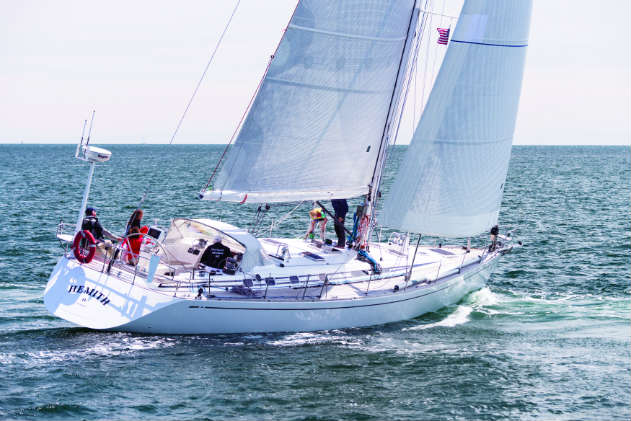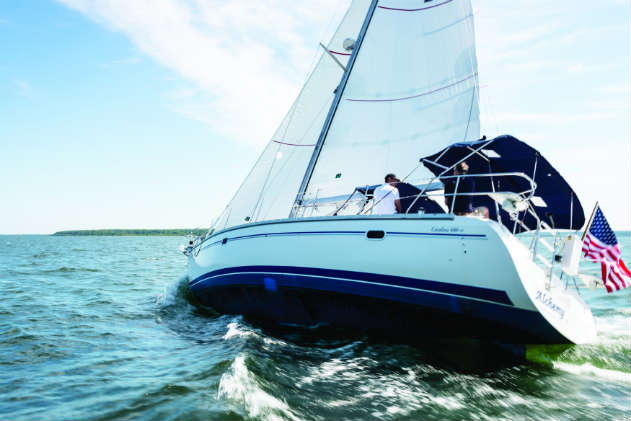Sail Trim and Technique for Cruising Sailors
I know, I know. You are cruising, so you don’t really care if you get to the weather mark two boat lengths ahead. At the same time it is nice to be able to sail instead of motor, to maintain control when it gets windy, and yes, maybe go a little faster. So without getting into the gory technical details and constant attention required to squeeze that extra 10th of a knot out, here are some simple thoughts that will help you sail better.

Reaching
If you play your cards right and the weather gods cooperate, most of the sailing you do when cruising will be on a reach. Even the least spritely cruising boat can reach. The most common sail trim mistake made when reaching is over-trimming. Pulling the sails in more does not increase the amount of power; it simply stalls the flow of air and keeps the sail from working properly. That’s why we put jib telltales on both sides of the sail so that we can make sure air is flowing on both the back and the front. The ancient adage “when in doubt, let it out” works. Ease until the sail luffs and pull back in just enough to stop from luffing, or to the point where both telltales are flowing straight aft.
On broad reaches and runs the mainsail can go all the way out against the rig if it is not luffing, as long as you have a boom vang to pull down and keep the boom from rising up. Even before you get to dead downwind, the mainsail can be all the way out at nearly a 90-degree angle. The mainsail will need chafe protection. For your headsail the cool trick to maximize efficiency is to move the jib lead outboard and maybe slightly forward. A second “short sheet” and a block on the rail will maintain the correct jib lead position when the sail is eased out and open up the gap between mainsail and jib (allowing you to ease the mainsail further without luffing). Think of it like this: the more you can let your sails out, the more of the force they create will be directed forward instead of sideways.
If you are overpowered when reaching, ease both sheets however much it takes to keep the boat on her feet. Let the sails luff if there is too much heel. If there are big changes in velocity, every puff will require an ease, and you can trim in the lulls. If the sails have to luff all the time to avoid heel and weather helm, it’s time to reef the mainsail or reduce headsail size.

Upwind
For many cruising boats sailing upwind is an unnatural act. Design choices such as reduced draft, increased beam, wider sheeting angles, and oh yeah, trying to carry your house around with you make upwind sailing difficult. At the same time improving your upwind ability can pay big dividends when you want to get home with the wind on the nose.
The trick is to sheet the sails in as hard as possible without violating the first principle of upwind performance, “speed first, then pointing.” If the boat is not moving well through the water, the keel won’t work and you will just go sideways. Remember, we have already reduced our draft and compromised our keel, so we really need to remember this rule. This means that in smooth water and medium breeze with the boat going well, we can sheet quite hard.
If using an overlapping headsail, it might be only an inch or two from contact with the spreader. Try sheeting this hard in light air, and the boat will never get going. Start with it eased (maybe a foot or two), and then gradually sheet in harder as the boat accelerates. You many never get closer than six inches or a foot. For the mainsail, trim until the top batten (or draft stripe on an in-mast furling mainsail) is parallel to the boom. If you have telltales on the leech, the top telltale will just be on the verge of stall (disappearing behind the sail). Once you get the leech setup, you can then put the boom on or near the centerline with the traveler for maximum power and pointing.
Now the ball is in the helmsperson’s court. They need to use the jib telltales to keep the boat locked in the groove. If you can’t see the telltales, it will be impossible to sail upwind well in light to moderate conditions.
When it gets windy and the boat heels too much, let the traveler down and/or ease mainsheet to keep the boat on her feet. At this point the helmsperson can begin to sail as much by angle of heel as by the telltales. In a puff, “feather; don’t fight.” Let the boat head up slightly to maintain a constant angle of heel rather than fighting the helm. It’s okay to let the front half of the mainsail luff if that’s what it takes to keep the boat on her feet. The inside jib telltales will be lifting constantly in the puffs as you let the boat come up. The beauty of feathering is that every puff is an opportunity to make ground upwind. If you need further de-powering, it is okay to ease the headsail sheet slightly (or just move the lead aft to twist and spill power off the top of the sail).
Downwind
In moderate conditions it’s easy; just point the boat where you want and go. If you want to go straight downwind, a whisker pole to hold the headsail clew out to weather is a big help. It provides better projected area and a wide steering groove without the sail collapsing.
The trickier part is getting downwind when the air is light (say under 10 knots). Here, the fastest course is not a straight line. Instead it pays to “tack downwind,” heading up until you can create enough apparent wind to fill the sails. Even though you sail a greater distance, the extra speed makes up for it. This is where specialty downwind sails (asymmetrical spinnakers) make a huge difference. No matter how big your primary headsail is, it’s not going to be very effective broad reaching. It is simply too heavy, has too little shape, and will be hidden behind the mainsail. What angle to sail? It changes as a function of velocity. Head up until the asymmetrical lifts and begins to fly. The apparent wind angle will probably be somewhere close to the beam if you look at your masthead fly. Once you have pressure, you can try sailing lower. If you get too deep, the sail will begin to droop, telling you that you have gone too far.
In heavy air don’t sail dead downwind. Head up 20 or 30 degrees to eliminate the potential for accidental gybes and to reduce the tendency of the boat to roll. Here, there is enough wind to make your primary headsail useful. It may even just be easier to leave the mainsail down and use your jib alone.
~By David Flynn
Questions? Email [email protected]




